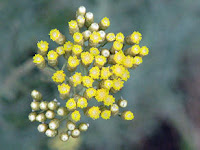
The curry plant is a curious and interesting little herb that may not be in the top five or ten choices on your herb wish list but definitely deserves your consideration.
Fast Facts About Curry Plant
Helichrysum italicum or curry plant is a tender perennial. Outdoors, it does best in U.S. zones 8 to 11. It can’t tolerate a hard frost. It prefers soil that drains well, full sun and warm conditions. It’s a perfect choice for intermittent drought prone areas or for a xeriscaped (low water) garden. If you have a spot behind a shed or garage that tends to reject your efforts to plant it out, curry plant may be a good choice there, too. It performs well in poor soil and isn’t finicky about niceties like pH (although keeping things on the neutral side wouldn’t hurt). Because it’s such a good sport about water, it doesn’t require mulching. It’s also a natural pest repellent. Bugs tend to avoid it, and deer hate it.
Growing to a height of about 30 inches or so, curry plant looks like a cross between lavender and rosemary. It has soft, gray-green foliage and produces small yellow flowers. It may require staking, especially in a windy location or a spot that sees a lot of foot traffic like a tree lawn.
Uses for Curry Plant
Curry plant is often promoted as an aromatic herb. Its common name derives from its scent, which can smell like curry. (As most of you know, curry is actually a blend of a variety of different spices that can vary from country to country and region to region.) When placed along a walkway, the aroma can be unexpected and enticing. To some folks, curry plant doesn’t smell as much like curry as something else — maple syrup. Regardless of how you interpret the aroma, it has a somewhat sweet, spicy and flowery note that seems at home with both sweet and savory fare.
I mention this because curry plant is sometimes maligned as pretty useless in the kitchen because it has a mild flavour. Much of its aroma is lost in cooking. As with pineapple sage, I think people expect curry plant to have more culinary power because it smells so nice. Even though curry plant isn’t the flavour powerhouse promised by its complex and very compelling scent, it is still useful in the kitchen. Actually, there are a lot of uses for curry plant: Chopped fine it compliments mild dishes and ingredients like eggs, yoghurt, mild cheeses and even fish. It enhances vinegar blends and makes a nice garnish, too. If you think you might like to try making an herb wreath, swag or even pot-pourri, curry plant will look and smell nice there as well.
Propagating Curry Plant
This useful little herb can be propagated from seed or cuttings, and the plant itself will survive for years in your landscape. It tends to get rangy and untidy after a while, though, and will become less productive after about the third or fourth year.
 Immature plants make unique gifts. Many gardeners are unfamiliar with curry plant and are immediately drawn to its aroma and soft, elongated, grey leaves. It’s adorable and unusual.
Immature plants make unique gifts. Many gardeners are unfamiliar with curry plant and are immediately drawn to its aroma and soft, elongated, grey leaves. It’s adorable and unusual.
Growing Curry Plant Indoors
Curry plant makes a very nice houseplant provided you can give it plenty of sun. This plant will need supplemental light if you can’t give it six to eight hours of powerful light a day. A southern exposure close to the window is ideal. I’ve kept a curry plant indoors for a couple of years now, putting it outside in spring and summer. As one of my commuter plants, it’s refreshingly undemanding. When it spends time in my kitchen, its spicy aroma is very noticeable and nice. Even when I’m not cooking, it smells like I have something delicious going on. If you do place curry plant in a pot, make sure to add some sand to the soil for good drainage, and water it sparingly.
If you’d like to expand your herb collection this year, I recommend curry plant. It’s a curiosity, but a fun and useful one.
[siblings]

Leave a Reply
You must be logged in to post a comment.